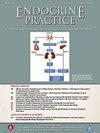Diabetes Status and Cardiovascular Complications Risk in Noncardiac Surgery: A Population-Based Cohort Study
IF 4.6
3区 医学
Q2 ENDOCRINOLOGY & METABOLISM
引用次数: 0
Abstract
Objective
Patients with diabetes are considered to be at high surgical risk due to the potential occurrence of cardiovascular and diabetes-related complications. Limited research exists on the cardiovascular risk profiles of patients with prediabetes and undiagnosed diabetes in noncardiac surgery. In this population-based cohort study, we investigated different glycated hemoglobin levels and their associated postoperative cardiovascular risks.
Methods
In this perioperative cohort study, participants were categorized into four groups: nondiabetes, prediabetes, undiagnosed diabetes, and diagnosed diabetes. The primary endpoint was the occurrence of major adverse cardiovascular events (MACE) at 30 days postoperatively, with secondary outcomes assessed at 90 days. The association between various groups and postoperative MACE was evaluated using Cox proportional hazards models and Kaplan-Meier curves. Subgroup analyses and sensitivity analyses were also performed.
Results
We enrolled 13 207 eligible patients undergoing noncardiac surgeries, among whom 3841 (29.08%) had prediabetes and 1521 (11.52%) had undiagnosed diabetes. In the 30-day postoperative period, the prediabetes group (hazard ratio [HR] [95% CI]: 1.70 [1.15, 2.52]), undiagnosed diabetes group (HR [95% CI]: 2.36 [1.15, 3.68]), and diagnosed diabetes group (HR [95% CI]: 2.33 [1.54, 3.53]) exhibited increased risks of MACE compared to the nondiabetes group. Similar findings were observed for the 90-day postoperative MACE. Further subgroup analysis revealed a significant interaction between sex and states of glycemic regulation (P for interaction < 0.005).
Conclusion
In this cohort, a notable proportion of patients with prediabetes or undiagnosed diabetes were found to be undergoing noncardiac surgeries. They were associated with an increased risk of developing postoperative MACE.
非心脏手术中糖尿病状况和心血管并发症风险:一项基于人群的队列研究
目的:糖尿病患者由于可能发生心血管和糖尿病相关并发症,被认为是手术风险较高的患者。关于糖尿病前期和未确诊糖尿病患者在非心脏手术中的心血管风险概况的研究有限。在这项基于人群的队列研究中,我们调查了不同的糖化血红蛋白(HbA1c)水平及其相关的术后心血管风险。方法:在这项围手术期队列研究中,参与者被分为四组:非糖尿病、前驱糖尿病、未确诊糖尿病和确诊糖尿病。主要终点是术后30天主要不良心血管事件(MACE)的发生,次要终点在90天评估。采用Cox比例风险模型和Kaplan-Meier曲线评价各组与术后MACE的相关性。同时进行亚组分析和敏感性分析。结果:我们纳入了13207例接受非心脏手术的符合条件的患者,其中3841例(29.08%)患有前驱糖尿病,1521例(11.52%)患有未确诊的糖尿病。术后30天,糖尿病前期组(HR [95% CI]: 1.70[1.15, 2.52])、未确诊糖尿病组(HR [95% CI]: 2.36[1.15, 3.68])和确诊糖尿病组(HR [95% CI]: 2.33[1.54, 3.53])发生MACE的风险均高于非糖尿病组。在术后90天的MACE中也观察到类似的结果。进一步的亚组分析显示,性别与血糖调节状态之间存在显著的相互作用(相互作用P < 0.005)。结论:在本队列中,有相当比例的糖尿病前期或未确诊的糖尿病患者接受了非心脏手术。它们与术后发生MACE的风险增加有关。
本文章由计算机程序翻译,如有差异,请以英文原文为准。
求助全文
约1分钟内获得全文
求助全文
来源期刊

Endocrine Practice
ENDOCRINOLOGY & METABOLISM-
CiteScore
7.60
自引率
2.40%
发文量
546
审稿时长
41 days
期刊介绍:
Endocrine Practice (ISSN: 1530-891X), a peer-reviewed journal published twelve times a year, is the official journal of the American Association of Clinical Endocrinologists (AACE). The primary mission of Endocrine Practice is to enhance the health care of patients with endocrine diseases through continuing education of practicing endocrinologists.
 求助内容:
求助内容: 应助结果提醒方式:
应助结果提醒方式:


